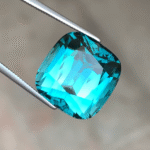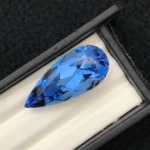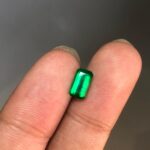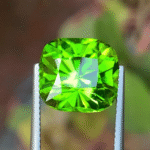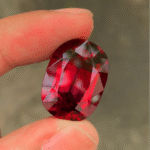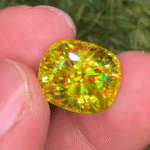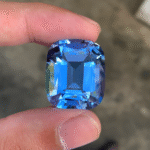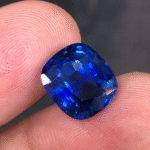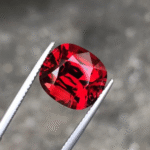September Birthstone Sapphire – Meaning, Color & Care
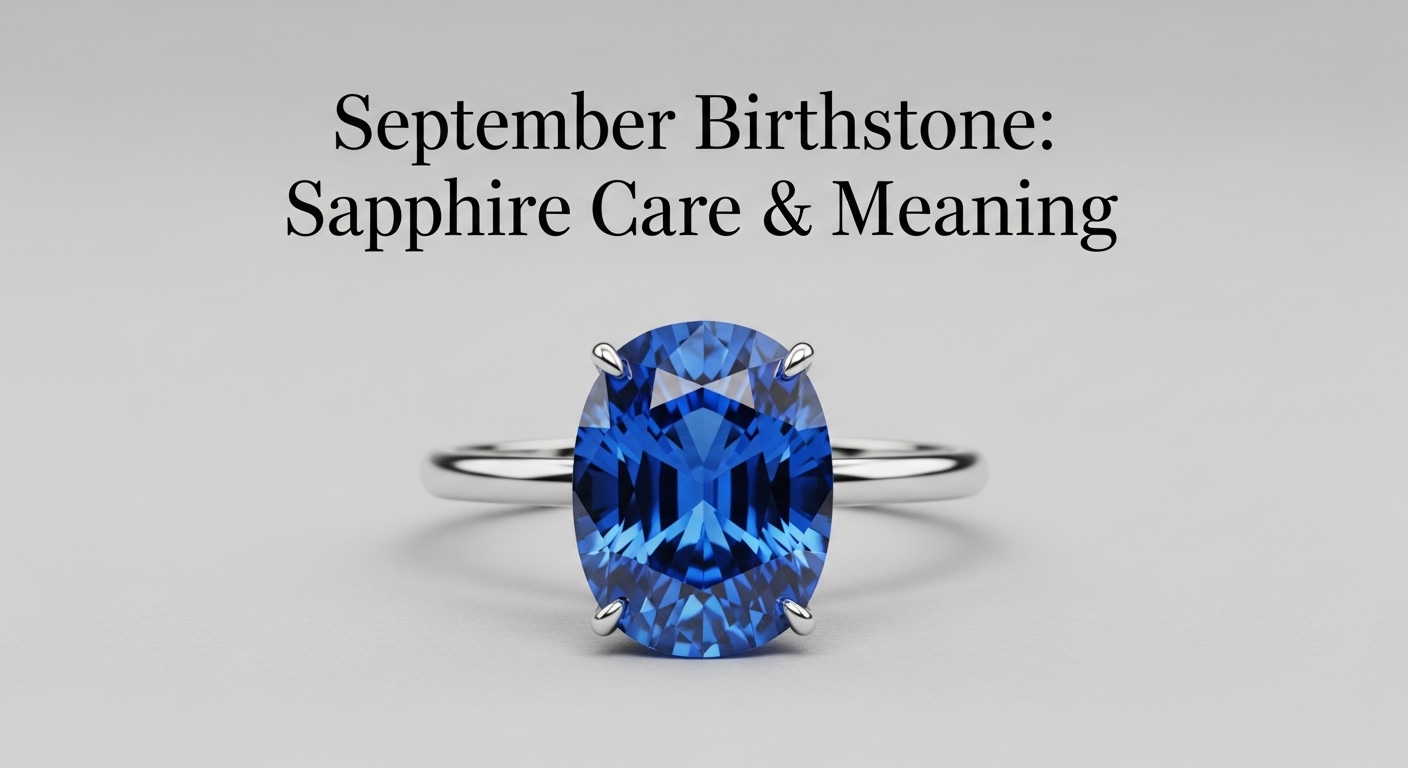
By The Crystals Library Team – Your trusted source for authentic crystal knowledge and spiritual guidance
What Is the Birthstone for September?
The September birthstone is sapphire – when I first held a sapphire in my hand, I realized why this gem has been so deeply cherished for thousands of years. The September birthstone is more than just a blue crystal; it’s a variety of the mineral corundum, with its sister stone being the ruby, known for its red fire. Across the rainbow of colors, sapphires carry meanings tied to royalty, romance, and qualities that symbolize fidelity and the soul. The Greek word “sappheiros” and the Latin “sapphirus” both mean “blue stone,” a nod to its history and the cultures that celebrated its characteristic hue. Among colored stones, the blue sapphire remains one of the most popular, often adorned in engagement rings to show clarity, trust, and enduring love.
Over time, I’ve noticed how September-born individuals are drawn to the renowned beauty of sapphires not just for their timeless allure, but also for the way they reflect symbolic meanings like wisdom, nobility, and inner peace. From a range of diverse options in color, each wearer finds a personal style that feels both stunning and sophisticated. The official stone of September, often treasured as a choice for birthdays, embodies elegance and vibrant charm. Its etymology and meanings have been appreciated across generations, where its enduring beauty and captivating presence are still symbolized as a mark of sophistication and a treasured bond with history.
September Birthstone History & Meaning
The September birthstone has been treasured for thousands of years and is traditionally known to have symbolized sincerity, truth, faithfulness, and nobility. In ancient Greece and Rome, the elite and rulers believed that blue sapphires could shield their owners from harm and envy, while clerics of the Middle Ages wore the stone as a symbol of Heaven. Even the Persians believed the earth rested on a giant sapphire that made the sky appear blue. Over the centuries, this gemstone was adorned in robes of clergy and admired across civilizations for its protective qualities. I’ve always found it fascinating how people from different societies and traditions connected this gem with wisdom, virtue, good fortune, and even divine favor.

Sapphires also carried a reputed power for healing—Medieval Europeans believed they cured plague, boils, and diseases of the eye, and even acted as an antidote to poison. Beyond symbolism, some famous sapphires highlight its lasting popularity: the Rockefeller Sapphire, a 62.02 ct rectangular step cut stone unearthed in Myanmar (Burma), once owned by John D. Rockefeller Jr. (1874–1960) after being acquired from an Indian maharaja, and later recut and remounted into a brooch and then a ring with cut-cornered triangular diamond side stones. Another iconic example is the 12 ct blue gem surrounded by diamonds in the engagement ring first worn by Princess Diana and later given to Kate Middleton, now the Duchess of Cambridge. From literature to art, sapphires have been inspired, culturally significant, and symbolic of honesty, integrity, loyalty, and fidelity, making them a truly meaningful choice for those born in September.
Where do sapphires come from?
Sapphires are found in historically important sources across Asia, Africa, and even the United States. The September birthstone has been discovered in different countries for thousands of years, with each region giving these gems a unique reputation and coveted beauty.
-
Sapphires appear in significant quantities in Sri Lanka, Kashmir, Myanmar (Burma), Australia, Thailand, Cambodia, Madagascar, and Montana (USA).
-
Each location produces stones with distinctive colours, from cornflower blue crystals to rich, intense hues.
-
Over time, auction houses have sold fine pieces of sapphire jewelry from these regions, showing their lasting global demand.
Kashmir
In 1881, a landslide in the Himalayas revealed a pocket of velvety blue crystals. The Maharaja and his army controlled the locality, and between 1882 and 1887, thousands of large, beautiful sapphires were recovered and faceted, giving Kashmir sapphires their world-famous coveted status.
Myanmar (Burma)
The Mogok area is a locale famed for producing sapphires. Nestled among jungle-clad hills and mountains, these stones often occur with ruby deposits. Known as Burmese sapphire, they display a rich, intense hue and are highly prized, alongside other gem materials like jadeite jade, spinel, zircon, amethyst, and peridot.
Sri Lanka
Also known as Ceylon, Sri Lanka has long been a major source of sapphires. The island yields gemstones in a wide range of colours, from pale ice blue to cobalt, and even orange-pink, golden, white, and black.
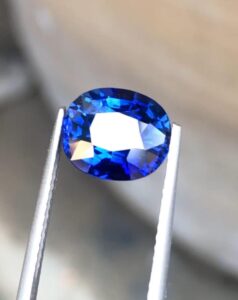
Madagascar & Africa
Madagascar and Eastern Africa are modern locations for high-quality sapphire deposits. Here, sapphires are often formed in metamorphic and igneous rocks like gneisses and granulites, deep within the earth’s crust at 6–18 miles under intense pressure and high temperatures.
Australia, Thailand & Cambodia
These countries supply sapphires in smaller quantities, often used in jewellery and even statues. Brilliant Earth highlights Australia and Sri Lanka among their key sources, but other suppliers include India and Colombia.
Unique Varieties
Some sapphires show rutile (the ore form of titanium) intrusions, creating the six-point star known as the star sapphire. This asterism gives the gem a special charm, though it’s considered a less pure form of sapphire.
September Birthstone Sapphire Color
When people think of September birthdays, the Sapphire immediately comes to mind. This famous gemstone belongs to the corundum mineral family, where its crystal structure and trace iron or titanium create the most rich, velvety, and deep blue shades. I still remember the first time I saw a finely cut and polished sapphire ring — the brilliant luster and how the light danced through the crystal was truly a mesmerizing display. Unlike rubies (also formed from corundum but with a red coloration), sapphires offer a full spectrum of colors that feel just as valuable and remarkable in jewellery pieces. These birthstones are not only prized but also carry a unique history across cultures, often considered one of the big three coloured gemstones with rubies and emeralds.
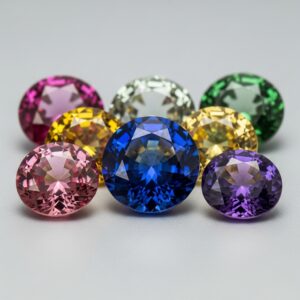
If you’re looking to own a natural piece of this history, explore our Loose Sapphire Gemstone for Sale 3.53 ct — a stunning choice for jewelry or collection.
Over time, I’ve noticed that each colour variation of sapphire tells its own story, shaped by the minerals present during its formation. Some shades gain popularity due to their romance, rarity, or luxurious appeal. Whether it’s a timeless engagement ring, a wedding jewellery set, or a distinct stone admired for its extraordinary hues, sapphires remain a personal favorite of mine for both their beauty and durability. Here’s how these natural colours stand out:
-
Blue Sapphire: The most popular, well-established, and valuable, admired for their intense colour and presence in classic sapphire jewellery.
-
Pink Saphhire: Known for growing popularity, symbolizing romance and rarity, often seen in modern engagement rings.
-
Yellow Sapphire: A stunning yet durable option, especially sought after since the early 2000s for unique jewellery sets.
-
Padparadscha (pink-orange hue): The rarest, highly prized, and often worn by famous women in extravagant pieces.
-
Purple & Green: Resulting from vanadium or iron, offering unusual yet fascinating colours within the sapphire spectrum.
-
Star Sapphire: An extraordinary gemstone with a distinct crystal structure that creates a starlike display, tied to a rich history of luxurious jewellery.
September Birthstone Saphhire Care & Maintenance
September Birthstone Sapphire Care & Maintenance is simple: keep it clean with gentle methods and avoid harsh chemicals or extreme conditions. With the right care, your sapphire jewelry will stay brilliant for years.
The September birthstone is relatively hard, with a ranking of 9 on the Mohs scale, giving it excellent toughness and making it a great choice for rings or mountings subject to daily wear. However, sapphires are often treated to improve color and clarity through heat treatment or other treatments like lattice diffusion, fracture filling, or dyeing, so it’s wise to always ask about the method before you buy a sapphire.
To give these birthstones the special care they deserve, I personally use warm soapy water or a soft brush with mild soap solution, which is safe for untreated, heat-treated, and diffusion–treated stones. For fracture-filled or dyed material, a damp cloth works best since they can be damaged by even mild acids like lemon juice. I recommend ultrasonic or steam cleaners only if the stone is not chipped or recut, as shallow induced color may be removed. To maintain brilliance, practice gentle handling, occasional cleaning, and avoid exposure to harsh chemicals or extreme temperatures to keep your jewelry shining with low-maintenance elegance.
-
Ranking 9 Mohs scale → Strong enough for daily wear
-
Heat treatment & lattice diffusion → Common and permanent in trade
-
Fracture-filled, dyed stones → Need extra care, avoid acids
-
Warm soapy water, mild soap, soft brush → Safest cleaning methods
-
Avoid harsh chemicals & extreme temperatures → Preserves brilliance
Conclusion
The September birthstone, Sapphire, is loved for its beauty, strength, and lasting brilliance. With a hardness of 9 on the Mohs scale, it is one of the most durable gemstones, making it perfect for daily wear in rings and jewelry. However, because many sapphires are heat-treated or enhanced, it is important to know the treatment method before buying. Proper care and maintenance—such as cleaning with warm soapy water, using a soft brush, and avoiding harsh chemicals or extreme temperatures—will keep your sapphire looking stunning for years. By following these simple tips, your sapphire jewelry will remain a timeless treasure and a meaningful September birthstone.
Frequently Asked Questions about September Birthstone
Q. What are the two birthstones for September?
September has two birthstones: Sapphire and Lapis Lazuli.
Q. Does September have three birthstones?
No, September officially has two birthstones, not three.
Q. What is the color for September birthday?
The main color for September birthdays is deep blue, the color of Sapphire.
Q. Is September birthstone rare?
Yes, Sapphires can be rare, especially high-quality natural stones without treatment.
Q. What are the two birthstones for each month?
Most months have one or two birthstones, but the list varies. September has Sapphire and Lapis Lazuli.
Q. What birth month is a sapphire?
Sapphire is the birthstone for September.
Q. What month has the rarest birthstone?
December is often considered to have the rarest birthstone, Tanzanite.
Q. What is the birthstone for all 12 months?
-
January: Garnet
-
February: Amethyst
-
March: Aquamarine, Bloodstone
-
April: Diamond
-
May: Emerald
-
June: Pearl, Alexandrite, Moonstone
-
July: Ruby
-
August: Peridot, Spinel, Sardonyx
-
September: Sapphire, Lapis Lazuli
-
October: Opal, Tourmaline
-
November: Topaz, Citrine
-
December: Turquoise, Zircon, Tanzanite

